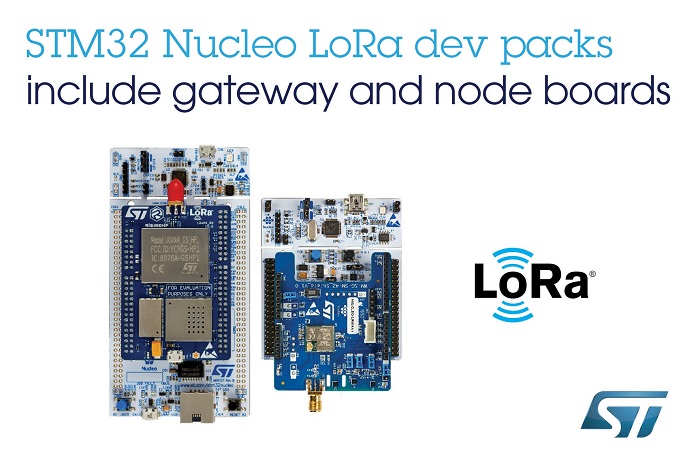By Gina Roos, editor-in-chief
STMicroelectronics has released two $99 LoRa development packs, leveraging the company’s STM32 Nucleo evaluation boards, that can be used by large corporations, smaller companies, independent designers, hobbyists, and schools. The dev packs enable users to develop new projects using LoRa’s long-range, low-power wireless IoT connectivity for applications such as tracking, positioning, and metering.
The two dev packs offer a complete LoRaWAN development chain including gateway and end-node boards, firmware, and tools. Separately targeting regions with 868 MHz/915 MHz/923 MHz and sub-550-MHz ISM frequency bands, each pack includes proprietary gateway software and ST’s I-CUBE-LRWAN end-node software. The node and gateway boards come with an antenna and on-board debugger.
The LoRa gateway is based on the STM32 Nucleo-144 development board, NUCLEO-F746ZG , which contains an STM32F746ZGT6 microcontroller (MCU). Users can easily access device pins to assist development, said STMicroelectronics, unlike a commercial gateway. The gateway acts as a basic packet forwarder to enable data coming from the development node to reach LoRaWAN network servers.

ST has agreements with LoRaWAN network-server providers LORIOT, Actility , and The Things Network that allow users to connect their gateways to basic network-server capabilities free of charge. For ease of use, designers can use the myDevices Cayenne for LoRa IoT Builder dashboard to visualize sensor data and control devices.
Nodes are based on the NUCLEO-L073RZ Nucleo-64 board that features the STM32L073RZT6 ultra-low-power MCU, and come with a battery socket for easy mobility. Each pack includes a LoRa node expansion board with an ultra-low-power STM32-powered module running an AT-command stack. Users also get access to a variety of motion and environmental sensors.
The P-NUCLEO-LRWAN2 pack is designed for high-frequency (868 MHz/915 MHz/923 MHz) ISM bands. It includes the I-NUCLEO-LRWAN1 node expansion board designed by USI, which combines an STM32L0-powered module with ST’s sensor devices including the LSM303AGR MEMS e-compass (accelerometer/magnetometer), LPS22HB pressure sensor, and ST HTS221 temperature and humidity sensor.
The P-NUCLEO-LRWAN3 pack for low-frequency (433 MHz/470 MHz) ISM regions comes with a node expansion board with an STM32L0-powered RisingHF module RHF0M003, ST LSM6DS33D accelerometer, ST LPS22HB pressure sensor, and HTS221 temperature and humidity sensor.
Available now, both development packs also include free integrated development environments (IDEs) such as Keil MDK-ARM, as well as a software toolset including the STM32CubeMX MCU initializer and configurator.
Advertisement
Learn more about Electronic Products Magazine





